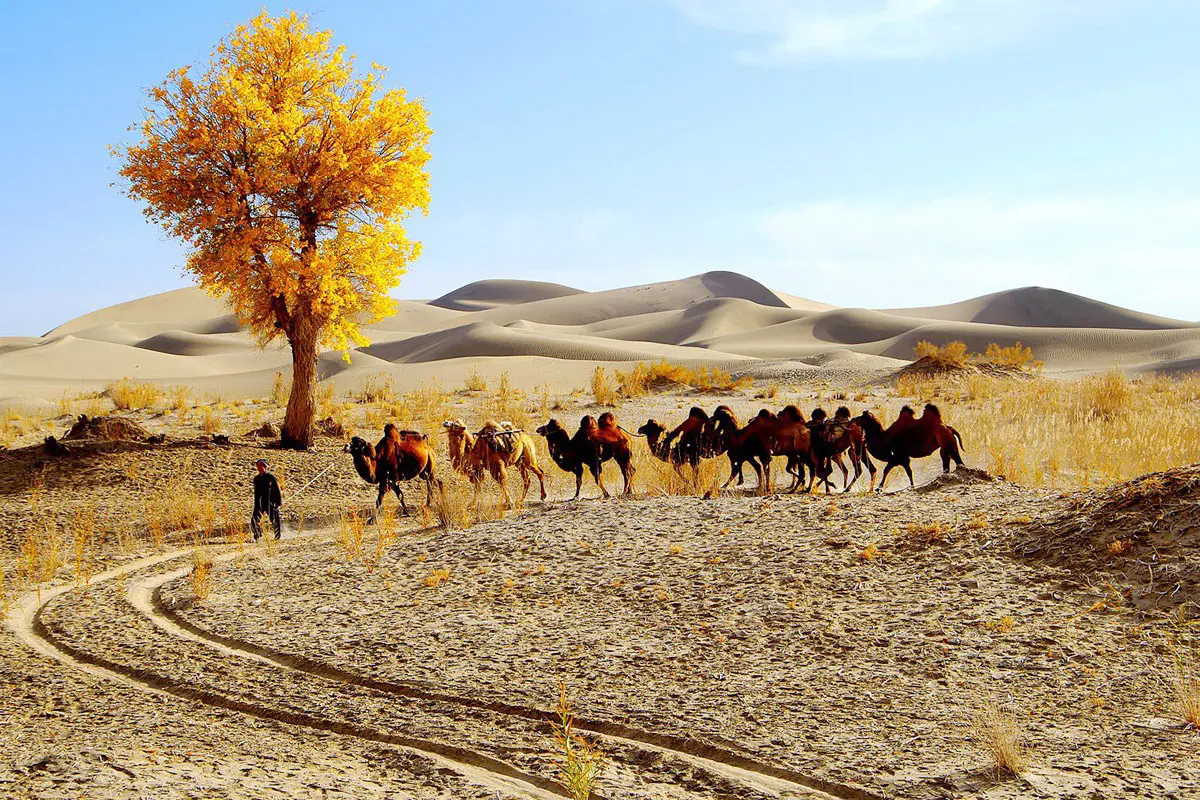American culture has so infused the popular imagination that the idea of a road trip is dominated by images of Cadillacs cruising Route 66 and characters like Jack Kerouac hitching at windswept truck stops. Just as poetic and eye-opening is a road trip across the Taklamakan Desert, the vast sandy expanse sprawling across China’s northwestern Xinjiang province.
Of course, the Taklamakan was crossed and re-crossed by countless peoples long before the modern road was built. Since time immemorial it has attracted merchants and mystics, adventurers and fortune seekers, explorers and archaeologists. From its sandy reaches, the ancient Tocharians emerged, a Buddhist European people; oasis cities sprang up; later came the Turkic tribes on their great westward migration; and around the desert’s perimeters travelled the plodding caravans and exotic cargoes of the Silk Road.
For the modern traveler, a trip along the southern Silk Road, skirting the Taklamakan, passing through the city of Yarkent and onward, offers a an opportunity to discover a realm where peoples and cultures have intermingled for millennia.
Heading southeast from the outskirts of Kaşgar the highway runs through fertile farmland. Neat plots of poplar trees line the road. There is a narrow perimeter of cotton fields and local Uyghur farmers busily tend garden plots and orchards of almond trees. But in the near distance, the dust encroaches and the greenery retreats.
As the road continues to snake southeast the first rugged tamarisk trees appear. With spindly green foliage and wisps of russet-colored flowers, these trees can withstand the extremes of temperature that are characteristic of the desert fringe. The terrain here is not stereotypical sandy desert, but features sparse patches of scrub amid undulating dunes of dusty gravel.
Yengihisar famed for its knives
Some 70 kilometers from Kaşgar is the town of Yengihisar, famed for its knives. Yengihisar would not appear out of place in an American road novel. It consists of a string of knife factory-showrooms clinging to the highway that bisects the town. Each of the showrooms boasts an impressive array of knives, all of which are intricately decorated.
Artisans in Yengihisar fashion each knife individually, crafting the blade and handle from a single length of metal, then inlaying sheep’s horn, nacre or camel bone or engraving in delicate calligraphy to make distinctive works of art. Knives come in all sizes and shapes, some with sheaths, some folding pocket knives. They are extremely sharp, their blades honed with love by local craftsmen.
The history of knife making in Yengihisar extends back over 400 years. There was a time when every self-respecting Uyghur man hung a Yengihisar knife from his belt; these were practical tools useful for hunting and other daily tasks, but were also symbols of masculinity.
Beyond Yengihisar, a lake appears, a surprise in this parched landscape, but soon the gritty dunes take over again. There is almost a pattern to the pebbled rises and falls, as if a giant retreating tide has left behind it ripples of sand and grit. As the sun beats down on the highway the traveler can watch the heat shimmering across the landscape. There is a hypnotic effect as the miles tick by, with the telegraph poles flashing past in a steady rhythm.
But the terrain is not entirely devoid of life. Occasional villages and small settlements hug the highway. Far from the major cities of the region, these villages are repositories of traditional life and architecture. Locals still build new homes using materials at hand. Houses are mud walled with a roof of lashed timber. A walled courtyard protects a veranda supported by carved poplar columns; here the family gathers on raised sitting platforms in the cool evening to share meals and recount the events of the day.
At Kızıl, 40 kilometers onward from Yengihisar, roadside market stalls are set up. Travelers can break their journey to sample the delights of fruits grown in local garden plots. Other stalls sell locally crafted pottery or woodwork. One shop, little more than a tin-roofed shed sparkling with fairy lights, features an Aladdin’s cave of tespih prayer beads, glass amulets, ceramic tea bowls, vases and painted decorative gourds.
After Kızıl the road crosses storybook desert, broad expanses of rolling sand dune, broken only by the regular sentinels of telegraph poles and the occasional billboard. One billboard is emblazoned with the features of Nasreddin Hoca, a face familiar to travelers to Turkey. The local Uyghurs know him as Nasreddin Effendi, and here he is advertising agricultural fertilizers, apparently.
After traversing a long stretch of sand the highway reaches the oasis of Yarkent. The roadside plots of slim poplar trees are the first indication that civilization is at hand. Villages and farms appear and orchards of almond and apricot trees. Hardy Uyghur farmers, both men and women, work the soil. The greenery is in stark contrast to the desert beyond; it shows that despite the harshness of the desert the land is startlingly fertile where water is present.
Yarkent has a long history. It was an important staging post when the Chinese Han emperors opened the Silk Road to the West over 2000 years ago. Islam arrived with the Karahanlı around 1000 years ago, and the city was a base for Genghis Khan‘s son Çağatay in the 13th century. It was also a terminus for trade caravans crossing the mountain passes to and from Ladakh and onward to India.
The Uyghur old town
Today, Yarkent is growing quickly like other cities in Xinjiang province. It expands in a flurry of building projects, but at its heart is the Uyghur old town. In this confined maze of streets, life proceeds at a measured pace. It’s a place of commerce and small-scale manufacturing, but also of communal life. Family groups wander and stop to chat amongst market stalls. Craftsmen chisel and weld and sharpen knives, and ironsmiths hammer tin buckets, yet all have time to drop tools and watch life in the street.
In the market the produce of the surrounding orchards is available. Red peppers, pumpkins, yellow carrots and beans are haggled over by canny Uyghur women. And there is food to go, too: whole roasted sheep basted with eggs, or plump melons cut to order by a smiling man with a razor-sharp knife.
In 1514, under Sultan Said Khan, Yarkent became the capital of an independent khanate, a confederation known as the altışehir, comprised of the six cities of Yarkent, Hotan, Aksu, Kaşgar, Yengihisar and Uç Turpan. History remembers the reign of the Saidiye hans, as an era of order and prosperity, when peasants could leave tools in the fields overnight and villagers left houses unlocked.
Little remains from that distant time except the Altın Mosque and the nearby cemetery which contains the royal tombs of the Saidiye khans and their families. Wandering and taking photos amongst the tombs, Uyghur families come to pay their respects, but the most popular and grandest tomb, decorated in fabulous tilework, is that of Amannisa Hanım.
Born to a humble woodcutter, Amannisa won the heart of the khan of Yarkand in 1539 when he heard her singing in the forest. She is renowned as a poet and for documenting and preserving the 12 makams, the distinctive musical canon of the Uyghur minstrels of the Taklamakan.
In the evening, in the square before Amannisa’s tomb, white doves flutter and pilgrims and school children gather. Here, lulled by the rhythms of Yarkent, the traveler can reflect on this very distinctive road-trip experience as the muezzin raises his cry, a moon ascends and night settles over the Taklamakan.

